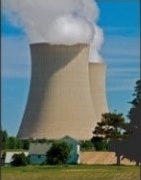As we consider this energy option it is key to bear in mind that the manipulation following this disaster means the full scale of damage can only be guessed at
By Kate Brown
Powerful storms, record-breaking temperatures and rising water levels remind us daily of the impact of climate change and our need to address it. Policymakers are debating what shape the post-carbon future will take and SA is one country where that conversation is taking place.
Proponents of nuclear power argue that nuclear energy is the most viable and powerful alternative to fossil fuels. Opponents point to waste storage problems, plus the slow pace and high cost of building new reactors. And, they ask, what about when something goes wrong?
I recently published a book called Manual for Survival: A Chernobyl Guide to the Future, about the 1986 explosion of reactor number four at the Chernobyl nuclear power plant in Ukraine, which was at the time a republic in the Soviet Union. I found as I worked through 27 archives that much of what we are told about the Chernobyl accident is incomplete or incorrect. People were far sicker and far more people died than we are led to believe. Chernobyl contaminants were not safely enclosed within the Chernobyl Zone. Nor has the chapter been closed. We are still ingesting Chernobyl fallout from 33 years ago.
[…]
First, shortly after the accident, pilots chased clouds of radioactive fallout flowing northeast from the burning reactor. They manipulated the weather to make radioactive rain land on rural Belarus in order to save several Russian cities, including Moscow. That triage operation saved the contamination of millions of people but created a second Chernobyl Zone that few know about today.
At the time, Moscow officials told no one in Belarus about the weather manipulation operation. The head of the Belarusian communist party, Nikolai Sliunkov, only found out about the accident, about 5km over the Belarusian border, by phoning the head of the Ukrainian communist party several days later. The 200,000 people who lived in the Mogilev province under the seeded clouds of fallout were mostly farmers. They ate what they grew and lived with high levels of radioactivity for up to 15 years until the territory was finally evacuated in 1999.
Nor is nature in the zone thriving. I observed the work of two biologists, Tim Mousseau and Anders Møller, who have since 2000 conducted twice-yearly experiments in the Chernobyl Zone and published hundreds of papers on their findings. Their studies show cascades of extinction in the most contaminated areas. “Every rock we turn over,” Mousseau commented, “we see damage.”
The records of the Soviet state committee for industrial agriculture reveal how radioactive contaminants concentrated in the food chain and in places of human habitation. A few weeks after the accident, Soviet shepherds corralled 100,000 head of livestock from a 60km radius around the Chernobyl plant. While teamsters drove the bleating animals to slaughterhouses, Moscow agronomists issued a special manual for meat packers with instructions to mix low- and medium-level radioactive flesh with appropriate proportions of clean meat to make sausage.
The sausage was to be labelled as it normally would and to be shipped across the great Soviet Union, everywhere but Moscow. Meat with high levels of radiation was to be stored in freezers until the radioactivity decayed. Soon managers in Belarus were asking for more freezers. They asked again and again, but no freezers arrived, so they located a refrigerated train car and packed in 317 tons of highly radioactive meat and sent the dubious gift to the Georgian Republic, where it was rejected and passed on.
For the next three years, the radioactive ghost train circled the western half of the Soviet Union; no-one wanted it. Finally, four years later, KGB agents buried the train and its radioactive meat inside the Chernobyl Zone, where it should have gone in the first place.
[…]
The insistence on selling radioactive food was not uniquely Soviet. Chernobyl fallout also landed in Greece and contaminated fields of grain. The Greeks harvested the grain and exported 300,000 tons to Italy. The Italians didn’t want the wheat. The Greeks refused to take it back because, they said, they were “afraid of the reaction from Greek wholesalers”. The two Mediterranean neighbours started fighting. Finally, the European Economic Community agreed to buy the contaminated wheat. They mixed it with clean grain and shipped it to Africa and East Germany as “aid”.
What were the effects of ingesting radioactive contaminants in food? Some Moscow experts in radiation medicine concurred with the UN and international experts in asserting that the doses villagers were taking in were too low to cause any detectable health problems.
The specialists made this prediction extrapolating from the Japanese bomb survivor Life Span Study. The study has a troubled political history. After the war, American officials were anxious that nuclear bombs would be banned like chemical and biological weapons. So they censored information about Japanese exposures to radioactivity and seized measurements of fallout which Japanese physicists had collected.
After tossing out Japanese scientists’ real-time measurements, American scientists had five years later to reconstruct doses survivors received. They included in their dose estimates only exposures from the bomb blast, one very large x-ray, and denied the fact of radioactive fallout. As calculated, a dose in the form of a large external x-ray differed greatly from the chronic low doses of radioactivity that residents of Chernobyl-contaminated territories ingested daily in their food, water and air.
Soviet doctors treating Chernobyl-exposed suddenly had an unwelcome crash course in this medical problem. They found that radioactive contaminants, even at relatively low levels, infiltrated the bodies of their patients, who grew sicker each year. Gradually, health officials understood they had a public health disaster on their hands. Thousands of archival records document the catastrophe. Ukrainian doctors registered in the most contaminated regions of Kiev province an increase between 1985 and 1988 in thyroid and heart disease, endocrine and GI tract disorders, anaemia and other maladies of the blood-forming system.
[…]
With these prospects, many women did not have the courage to reproduce. An uncommonly high percentage of women, up to 75%, chose to terminate their pregnancies. By 1989, doctors were noticing a dramatic rise in thyroid cancers and leukaemia among exposed children, normally very rare occurrences.
For three years, Soviet physicians had to sit on this information, telling no one but their bosses. Finally, in the spring of 1989, censors lifted the ban on Chernobyl topics. Residents made alliances with doctors and radiation monitors. They organised, petitioned, broke laws and carried on when dismissed as ignorant provincials in order to get the world to understand the new precarious life they led. Soviet officials found crowds on the streets more threatening than radioactivity. They called in UN agencies to send foreign experts to do an “independent assessment”.
[…]
Consultants from UN agencies dismissed the findings of scientists in Ukraine and Belarus. Again extrapolating from the Japanese Life Span Study, the UN experts stated in 1991 that radioactivity at Chernobyl levels would cause no major damage to human health except for the risk of a small number of future cancers among children. They reiterated this statement despite evidence they possessed and failed to publicly acknowledge of an alarming childhood cancer epidemic under way.
The denials came at a critical time. Just after UN consultants declared they found no Chernobyl health effects, the UN General Assembly held a pledge drive to raise $346m to help pay for resettling people living in highly contaminated regions and for a long-term epidemiological study on chronic low doses of radioactivity, something scientists around the world had called for since the Chernobyl plant blew. Unfortunately, the big donors begged off, pointing to UN experts’ assessment that there had been no Chernobyl health effects. As a consequence, the pledge drive raised less than $6m.
Why would UN officials whitewash evidence of Chernobyl health damage? At the time the US, Russia, France and the UK faced huge lawsuits from their own exposures of people to radioactive contamination during four decades of reckless bomb production. If they could assert that Chernobyl was “the worst disaster in human history” and only 54 people died, then those lawsuits could go away. And that is indeed what happened.
Today, the low Chernobyl death toll is used as a rationale to continue building nuclear power plants; it’s said to be far safer than the thousands who die annually from burning coal. But that number — 54 dead — is incorrect. The Ukrainian state currently pays compensation not to 54 but to 35,000 people whose spouses died from Chernobyl-related health problems. This number only reckons the deaths of people old enough to marry. It does not include the mortality of young people, infants or people who did not have exposure records to qualify for compensation. Off the record, Ukrainian officials give a death toll of 150,000. That figure is only for Ukraine, not Russia or Belarus, where 70% of Chernobyl fallout landed.
Underestimating Chernobyl damage has left humans unprepared for the next disaster. When a tsunami crashed into the Fukushima Daiichi nuclear power plant in 2011, Japanese leaders responded in ways eerily similar to Soviet leaders: with denials, obfuscation and a declaration of bankruptcy. Today, 33 years after the Chernobyl accident, we are still short on answers and long on uncertainties. We understand little about low-dose exposure because no large-scale studies have been conducted.
Ignorance about low-dose exposures is tragic and not entirely accidental. Before SA leaders invest in a new generation of power reactors to stem global warming and solve SA’s energy crises, it would be smart to ask a new set of questions that is, finally, useful to people exposed over lifetimes to chronic doses of man-made radiation. Unfortunately, few people on earth have escaped those exposures.
Read more.




